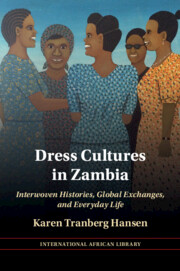Book contents
- Dress Cultures in Zambia
- The International African Library
- Dress Cultures in Zambia
- Copyright page
- Contents
- Figures
- Acknowledgements
- Prologue
- 1 Dress Practice as History
- Part I Dressing Well
- Part II Dress and Undress
- Part III Fashionable Transformations
- 7 Youth and Urban Cultures of Consumption
- 8 Fashioning Demonstrative Displays
- 9 Dressing Zambian
- Conclusion
- References
- Index
- Titles in the Series
Conclusion
from Part III - Fashionable Transformations
Published online by Cambridge University Press: 20 April 2023
- Dress Cultures in Zambia
- The International African Library
- Dress Cultures in Zambia
- Copyright page
- Contents
- Figures
- Acknowledgements
- Prologue
- 1 Dress Practice as History
- Part I Dressing Well
- Part II Dress and Undress
- Part III Fashionable Transformations
- 7 Youth and Urban Cultures of Consumption
- 8 Fashioning Demonstrative Displays
- 9 Dressing Zambian
- Conclusion
- References
- Index
- Titles in the Series
Summary
Much as in the rest of Africa and elsewhere, dress fashions in Zambia have their own histories and global interconnections. Dress has mattered enormously in Zambia’s history and continues to do so today, as I have demonstrated in this book, arguing that dressed bodies are the point of contact between local knowledge and the broader global context. Rich, dynamic, and globally interwoven histories shaped local material culture with commodities and ideas from far away, introducing new textile and clothing practices that people in the region that today is Zambia adapted to their own cultural sensibilities about bodies and dress. In the process, they absorbed diverse and changing styles, creating dress repertoires inspired, for men, by standard formal wear in the West as well as the colonial bush suit and Chinese and Indian elements, and renaming kente cloth from Ghana as kanga with a term for an East African cloth. Inspirations for women entailed a lively fusion of dress from the West and the rest of Africa with occasional references to India. Zambian women pan-Africanised specific dress elements fusing ‘West African’ and ‘Nigerian boubou’ while accessorising their chitenge outfits with dukus, a name for a head-tie from Ghana. They made their own dress, chitenge, from African prints produced in Europe with Indonesian inspirations during the colonial era and subsequently developed for export to African markets. Today, most of the African prints sold across the continent are manufactured by Chinese textile firms. And during the 1990s dresses tailored from colourful chitenge fabrics sold by suitcase traders in South Africa were called ‘Zambia’. With its multiple inspirations and ever-changing styling, dress in Zambia draws on many cultural referents in the creation of a recognisably local touch of elegance.
- Type
- Chapter
- Information
- Dress Cultures in ZambiaInterwoven Histories, Global Exchanges, and Everyday Life, pp. 176 - 181Publisher: Cambridge University PressPrint publication year: 2023

